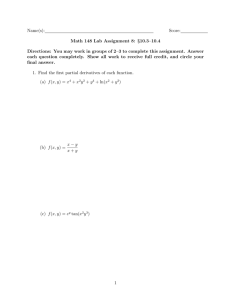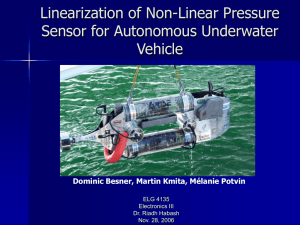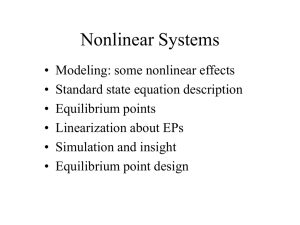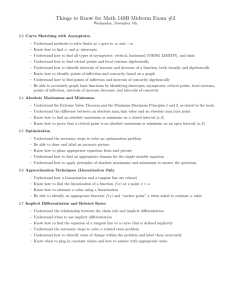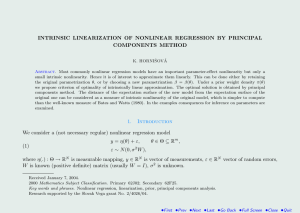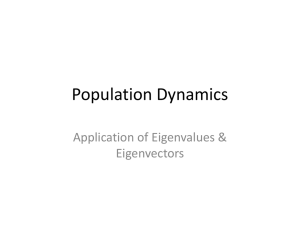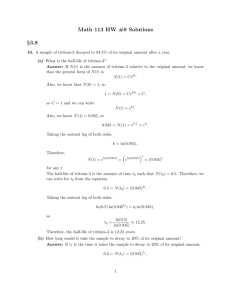207 INTRINSIC LINEARIZATION OF NONLINEAR REGRESSION BY PRINCIPAL COMPONENTS METHOD
advertisement
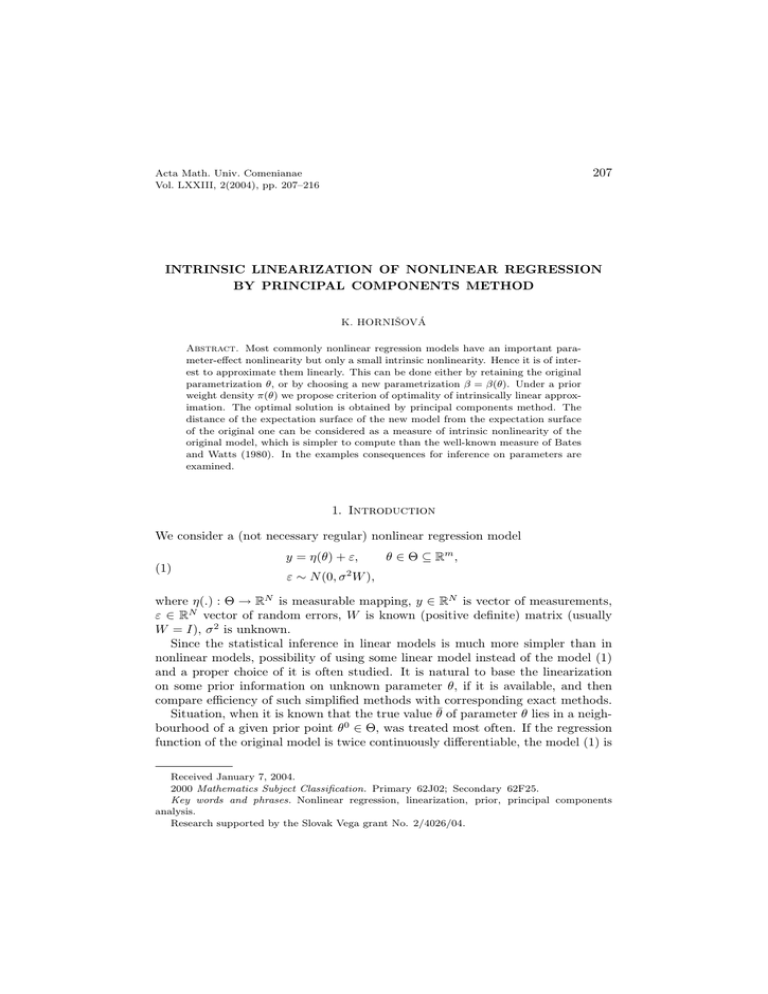
207
Acta Math. Univ. Comenianae
Vol. LXXIII, 2(2004), pp. 207–216
INTRINSIC LINEARIZATION OF NONLINEAR REGRESSION
BY PRINCIPAL COMPONENTS METHOD
K. HORNIŠOVÁ
Abstract. Most commonly nonlinear regression models have an important parameter-effect nonlinearity but only a small intrinsic nonlinearity. Hence it is of interest to approximate them linearly. This can be done either by retaining the original
parametrization θ, or by choosing a new parametrization β = β(θ). Under a prior
weight density π(θ) we propose criterion of optimality of intrinsically linear approximation. The optimal solution is obtained by principal components method. The
distance of the expectation surface of the new model from the expectation surface
of the original one can be considered as a measure of intrinsic nonlinearity of the
original model, which is simpler to compute than the well-known measure of Bates
and Watts (1980). In the examples consequences for inference on parameters are
examined.
1. Introduction
We consider a (not necessary regular) nonlinear regression model
y = η(θ) + ε,
(1)
θ ∈ Θ ⊆ Rm ,
ε ∼ N (0, σ 2 W ),
where η(.) : Θ → RN is measurable mapping, y ∈ RN is vector of measurements,
ε ∈ RN vector of random errors, W is known (positive definite) matrix (usually
W = I), σ 2 is unknown.
Since the statistical inference in linear models is much more simpler than in
nonlinear models, possibility of using some linear model instead of the model (1)
and a proper choice of it is often studied. It is natural to base the linearization
on some prior information on unknown parameter θ, if it is available, and then
compare efficiency of such simplified methods with corresponding exact methods.
Situation, when it is known that the true value θ̄ of parameter θ lies in a neighbourhood of a given prior point θ0 ∈ Θ, was treated most often. If the regression
function of the original model is twice continuously differentiable, the model (1) is
Received January 7, 2004.
2000 Mathematics Subject Classification. Primary 62J02; Secondary 62F25.
Key words and phrases. Nonlinear regression, linearization, prior, principal components
analysis.
Research supported by the Slovak Vega grant No. 2/4026/04.
208
K. HORNIŠOVÁ
then linearized by the linear part of its Taylor expansion at θ0 , i.e. by the model
(2)
∂η(θ0 )
(θ − θ0 ) + ε = Aθ + a + ε,
∂θ>
ε ∼ N (0, σ 2 W ).
y = η(θ0 ) +
Similarly can be linearized arbitrary parametric function g(θ) of interest. Properties and conditions on admissibility of Taylor linearization in a prior point were
studied e.g. in [4].
Sometimes, the prior distribution π on Θ is known. For this case, different
ways of linearization of (1) were proposed. For one of the methods – nonstandard
linearization, see [6].
Another way how to linearize the model (1) utilizing the knowledge of prior π
is linearization by smoothing, proposed in [7]. The approximative linear model
Y = Aθ + a + ε,
(3)
ε ∼ N (0, σ 2 W ),
is chosen according to the criterion
K1 :=
min
A∈RN ×m
a∈RN
(4)
E π [kη(θ) − (Aθ + a)k2W ]
Z
=
kη(θ) − (Aθ + a)k2W π(θ)dθ.
min
A∈RN ×m
a∈RN
Θ
The solutions of the minimization problem (4), which corresponds to minimization
of prior expectation of I-divergence between the nonlinear and linear model, have
the form
A = Cov π (η, θ)(Var π θ)− ,
(5)
a = E π η − A E π θ,
K1 = tr W −1/2 {Var π η − Cov π (η, θ)(Var π θ)− Cov π (θ, η)}W −1/2 ,
where the last expression is invariant with regard to the choice of pseudoinversion
(Var π θ)− , if the indicated means and covariances with regard to prior distribution
π(.) on Θ exist and are finite. Parametric functions of interest can be linearized
accordingly.
The advantage of the method is that it can be used also when the response
function η(θ) has no derivatives. In the other case
Aπn →
∂η(θ0 )
∂θ>
if
πn → π0 ,
where πn are nondegenerate prior distributions and π0 is distribution concentrated
at θ0 .
In [3], under the knowledge of joint prior π for (θ, σ), the linearization of the
model is circumvented and parametric function g(θ, σ) ∈ Rs of interest is directly
INTRINSIC LINEARIZATION OF NONLINEAR REGRESSION
209
estimated by explicit estimator ĝ(y), which is defined as linear combination AΦ(y),
A ∈ Rs×u , of given functions Φ(.) : Rn → Ru of observations, such that the coefficient A is optimal with regard to criterion (average mean square error (AMSE))
(6)
min E π E f (.|θ,σ) kg(θ) − AΦ(y)k2 ,
A∈Rs×u
where f (.|θ, σ) is conditional
density of y.
y
For example, if Φ(y) =
, then linear explicit estimator is AΦ(y) = A> y + a,
1
where
A = [Var π η + E π (σ 2 )W ]−1 Cov π (η, g),
(7)
and
a = E π g − A> E π η,
with
AMSE = tr{Var π g − Cov π (g, η)[Var π η + E π (σ 2 )W ]−1 Cov π (η, g)}.
2. Intrinsic linearization
Besides linear models, estimators in intrinsically linear models still have very good
statistical properties. (The model (1) is called intrinsically linear, if its expectation
surface
(8)
Eη = {η(θ); θ ∈ Θ}
is relatively open set of a s-dimensional plane of RN , where s ≤ m (Def. 2.2.1 in
[6])). The method of [7] parametrically linearize even intrinsically linear models,
which is often not necessary from statistical point of view. Therefore here we
present another method which approximates nonlinear model by intrinsically linear
one, so that the models which are originally intrinsically linear are not modified.
In the following example we show that linearization by smoothing can indeed
change expectation surface of intrinsically linear model very much.
Example 1. Let us consider intrinsically linear model
η(θ) = (cos2 θ, sin2 θ)> ; θ ∈ Θ ⊆ R1 .
Let prior π(.) is proper uniform probability distribution on Θ.
Expectation surface on the supp(π(.)) of the model is {(t, 1 − t)> ; t ∈< 0; 1 >}
in both cases a), b) considered below.
a) let Θ = (0; 2π)
Then the linearization by smoothing is singular:
1
1
A = 0̄,
a = 21 ,
K1 = ,
4
2
so that the expectation surface of linearization by smoothing is
1 2
{Aθ + a; θ ∈ Θ} =
.
1
2
210
K. HORNIŠOVÁ
b) let Θ = (0; π2 )
Then
12
−1
A=
,
2
π(π − 4) 1
1
a=
2
1
2
−
π
A,
4
K1 =
1
12
.
= 0.043
− 2 2
4 π (π − 4)
and the expectation surface of linearization by smoothing is an interval
1
3
1 .
3
t
+ ; 2
+
= (−0.011; 1.011)
{Aθ + a; θ ∈ Θ} =
: t∈ − 2
1−t
π −4 2 π −4 2
In contrast, the best intrinsic linearization problem can be understood as problem of best approximation of the expectation surface of original model (1) by the
expectation surface of some intrinsically linear model.
Let
y = ξ(θ) + ε ;
θ ∈ Θ,
(9)
2
ε ∼ N (0, σ W )
be an intrinsically linear model. It is known, (see [6]), that for every intrinsically
linear model there exists a parametrization, in which the model is a regular linear
model. Therefore expectation surface of model (9) is
Eξ = EA,a = Aβ + a : β ∈ Rk ,
for some reparametrization β = β(θ), A ∈ RN ×k , rank(A) = k, a ∈ RN , k ∈ N.
The distance of a point η(θ) ∈ Eη from Eξ in space RN with scalar product
< a, b >W := a> W −1 b is
d[η(θ), Eξ ] := min kη(θ) − zk2W ,
z∈Eξ
and
zopt (θ) := arg min kη(θ) − zk2W
z∈EA,a
is a W -orthogonal projection of η(θ) on Eξ .
Let β(θ) ∈ Rk be such that
zopt (θ) = Aβ(θ) + a.
Then
(10)
β(θ) = (A> W −1 A)−1 A> W −1 (η(θ) − a).
If we have some prior guess on the plausible values θ in the form of a prior weight
function π(θ), the global distance of Eξ from Eη can be measured by
Z
dπ (Eη , Eξ ) : =
kη(θ) − zopt (θ)k2W π(θ)dθ =
Θ
Z
=
kη(θ) − (Aβ(θ) + a)k2W π(θ)dθ =
ZΘ
=
kη(θ) − [A(A> W −1 A)−1 A> W −1 (η(θ) − a) + a]k2W π(θ)dθ.
Θ
Let q be the dimension of manifold Eη .
INTRINSIC LINEARIZATION OF NONLINEAR REGRESSION
211
In problem of intrinsic linearization of model (1) we consider as optimal such a
choice of A and a which is a solution of
(11)
min
k≤q
A∈RN ×k
rank(A)=k
a∈RN
dπ (Eη , EA,a ).
The solution of (11) is given in the following statement.
Theorem. The optimal choice of k, A, a is equal to
k = min{q, number of nonzero eigenvalues of Var π (W −1/2 η)},
A = W 1/2 (u1 , . . . , uk ),
(12)
where u1 , . . . , uN are orthonormal eigenvectors corresponding to eigenvalues λ1 ≥
· · · ≥ λN ≥ 0 of the matrix
Var π (W −1/2 η),
respectively,
a ∈ E π η + Ker(I − A(A> W −1 A)−1 A> W −1 ).
(12a)
There is exactly one k−dimensional affine manifold Eξ such that for every optimal
choice of A, a it holds that Eξ = EA,a .
min
k≤q
A∈RN ×k
rank(A)=k
a∈RN
dπ (Eη , EA,a ) =
N
X
i=k+1
λi =
N
X
λi .
i=q+1
Proof.
n
2 o
dπ (Eη , EA,a ) = E π (I − A(A> W −1 A)−1 A> W −1 )(η(θ) − a)W
>
= tr (I − A(A> W −1 A)−1 A> W −1 )(a − E π η)
· W −1 (I − A(A> W −1 A)−1 A> W −1 )(a − E π η)
+ tr W −1 Var π (I − A(A> W −1 A)−1 A> W −1 )η
≥ tr W −1 Var π (I − A(A> W −1 A)−1 A> W −1 )η ,
with equality iff a ∈ E π η + Ker(I − A(A> W −1 A)−1 A> W −1 ).
Now it is sufficient to solve the minimization problem
min tr W −1 Var π (I − A(A> W −1 A)−1 A> W −1 )η .
k≤q
A∈RN ×k
rank(A)=k
Since the matrix A(A> W −1 A)−1 A> W −1 is idempotent, the last problem is equivalent with the following one:
212
K. HORNIŠOVÁ
max
k≤q
A∈RN ×k
rank(A)=k
tr (W −1 A(A> W −1 A)−1 A> W −1 Var π η)
or (since A is optimal solution iff AD is optimal solution for arbitrary regular
Dk×k )
max
tr (A> W −1/2 Var π [W −1/2 η]W −1/2 A).
k≤q
A∈RN ×k
rank(A)=k
A> W −1 A=Ik
The last expression is a problem of principal component analysis of random quantity W −1/2 η, from which it follows that the solution has the form given in the
statement of the theorem.
The obtained intrinsically linear approximation of the original model (1) is equal
to
(13)
y = A(A> W −1 A)−1 A> W −1 (η(θ) − E π η) + E π η + ε,
ε ∼ N (0, σ 2 W ),
with A taken according to Theorem.
It is obvious that for arbitrary prior π, the original model (1), is intrinsically
linear (with π−probability 1) iff rank(Var π η) ≤ q.
From Theorem it also follows that the minimal squared “distance”
(14)
N
X
D1 :=
λi
i=k+1
of the linearized model (13) from the original model (1) can be understood as
measure of intrinsic nonlinearity of model (1).
Example 2 (continuing example 1). In both cases a) and b) the optimal matrices for intrinsic linearization are
!
1
− √12
2 ,
A=
,
a
=
D1 = 0,
1
√1
2
2
so the model (9) has the form
y=
cos2 θ
+ ε,
sin2 θ
ε ∼ N (0, σ 2 W ).
Example 3. Let
y=
θ
cθ2
+ ε,
ε ∼ N (0, σ 2 I2×2 ),
θ ∈ Θ = h−1, 1i,
INTRINSIC LINEARIZATION OF NONLINEAR REGRESSION
213
where c is some known positive constant. Let θ has proper uniform prior distribution π on Θ. Then the expectation of linearization by smoothing is
(θ, c/3)> .
The expectation of intrinsic linearization is
(
p
(θ, c/3)> ,
if c < 5/3,
p
(0, c θ2 )> ,
if c > 5/3,
i.e. in the latter case the expectation surface of intrinsic
linearization is orthogonal
p
to that of linearization by smoothing. If c = 5/3, the matrix Var π η has two
identical eigenvalues, so that intrinsic linearization is not uniquely determined.
Example 4. In [8] two three-parameter sigmoidal models are considered for
data set 1 from Appendix 4A on a vegetative growth process. The models are
yi = η(θ, xi ) + εi = θ1 exp[− exp(θ2 − θ3 xi )] + εi ,
>
2
ε = (ε1 , . . . , εN ) ∼ N (0, σ W )
i = 1, . . . , N,
(Gompertz model),
and
yi = η(θ, xi ) + εi =
θ1
+ εi ,
1 + exp(θ2 − θ3 xi )
ε = (ε1 , . . . , εN )> ∼ N (0, σ 2 W ),
i = 1, . . . , N,
(logistic model),
with σ 2 unknown, W = I. We consider here two normal prior distributions –
N (θ̂M L , s2 (y)M (θ̂M L )) (1), and N (θ̂M L , 25s2 (y)M (θ̂M L )) (2), where θ̂M L is maximum likelihood estimate in model (1),
s2 (y) :=
ky − η(θ̂M L )k2W
,
N −m
and
∂η > (θ) −1 ∂η(θ)
W
.
∂θ
∂θ>
Then the results based on 10000 simulations from prior distribution are (Kint and
Kpar are intrinsic and parametric nonlinearity measures from [1]):
M (θ) :=
Nonlinearity measure
Kint
Kpar
K1
D1
AMSE
Prior
1
2
1
2
1
2
Gompertz
9.010·10−2
2.324·100
3.000·100
1.000·103
4.000·10−3
1.500·100
2.000·101
3.000·102
Logistic
7.300·10−2
6.440·10−1
1.000·10−1
1.000·102
1.000·10−3
4.000·10−1
1.600·100
1.500·101
214
K. HORNIŠOVÁ
3. Nonlinear regression inference using intrinsically linear
approximation
Merits and shortcomings of the above described linearization methods will be compared at examples of point estimation and construction of confidence regions for
parameter θ. However, since computation of ML-estimate in intrinsically linearized
model is no easier than in original model, the importance of intrinsic linearization
is greater in interval estimation and prediction.
Example 5 (continuing Example 4). For data y from [8] and for 10000 simulations from prior distribution we get ML-estimates in original model (i), in
linearization by smoothing (ii), in intrinsic linearization (iii), and linear explicit
estimate (iv) of parameter θ:
Nonlinearity measure
θ1
θ2
θ3
Prior Method Gompertz
1
(i)
8.283 ·101
(ii)
8.360·101
(iii)
8.290·101
(iv)
8.300·101
2
(ii)
1.100 ·102
(iii)
8.400·101
(iv)
8.700·101
1
(i)
1.224 ·100
(ii)
1.230·100
(iii)
1.223·100
(iv)
1.227·100
2
(ii)
1.400 ·100
(iii)
1.200·100
(iv)
1.300·100
1
(i)
3.710 ·10−2
(ii)
3.720·10−2
(iii)
3.700·10−2
(iv)
3.710·10−2
2
(ii)
3.400 ·10−2
(iii)
3.600·10−2
(iv)
3.600·10−2
Logistic
7.246·101
7.254·101
7.245·101
7.249·101
7.500·101
7.260·101
7.250·101
2.618·100
2.623·100
2.619·100
2.621·100
2.720·100
2.610·100
2.660·100
6.740·10−2
6.750·10−2
6.740·10−2
6.730·10−2
6.940·10−2
6.720·10−2
6.830·10−2
There are several kinds of (1 − α)-confidence regions for parameter θ used in
nonlinear regression (see discussion in [5]). Here we compare the following ones:
regions based on likelihood ratio (exact only in intrinsically linear models)
(15)
ΘLR :=
(
θ ∈ Θ;
(N − m)(ky − η(θ)k2W − ky − η(θ̂)k2W )
mky − η(θ̂)k2W
where θ̂ is ML-estimate in model (1),
)
≤ Fm,M −m (1 − α) ,
INTRINSIC LINEARIZATION OF NONLINEAR REGRESSION
215
and regions based on projections
(N − p)kP (y − η(θ))k2W
(16)
ΘP := θ ∈ Θ;
≤ Fp,N −p (1 − α)
pk(I − P )(y − η(θ))k2W
where P is W −orthogonal projector, p = rank(P ). If P does not depend on y,
region (16) is exact in arbitrary model.
Note, It can happen that no region of the form (16) is good, since the set
MP of points µ ∈ RN which satisfy definition inequality of region (16) is a cone
(differently from the set MLR which is a ball), and intersections of expectation
surfaces of some models with such cones may be unbounded, too large, or, on the
contrary, void sets. See Figure 6.19 in [2].
For above given linearization methods it is natural to construct confidence regions for θ of the form (16) with
P = A(A> W −1 A)−1 A> W −1 ,
where A is optimal matrix from (2) (with θ0 = θ̂M L ), (5), (7) (with g(θ) := η(θ))
or (12). Corresponding P will be denoted PM L , PSM , PEX , PIN , respectively.
(Region for PM L without parts due to overlapping is almost exact in flat models
(see [5]). Among this class of confidence regions the confidence regions based on
intrinsic linearization, i.e. on projector PIN should violate the objection from the
Note against confidence regions of type (16) in the most vigorous degree possible
since (I −P ) in this case corresponds to the “direction” of apriori shortest diameter
of expectation surface. If the prior used is subjective, then intersection of such
confidence region with the support of prior can be used.
Example 6 (continuing Example 3). Point estimates of θ:
Linearization by smoothing: θ̂ = y1 .
Intrinsic linearization:
y1 ,
p
θ̂ =
y2 /c,
0,
p
5/3,
p
if c > 5/3 and y2 ≥ 0,
p
if c > 5/3 and y2 < 0.
if c <
Linear explicit estimation: θ̂ = 1/(1 + 3 E π2 (σ 2 )) y1 < y1 , where π2 is a prior
distribution for σ 2 , which is assumed to be independent of θ.
Since the prior π is uniform, ML-estimator of θ equals to posterior modus
estimator justified from the bayesian point of view. Therefore, quality of estimators
from various linearizations can be assessed by their closeness to ML-estimator.
Expressions for estimators of θ give an idea which linearization is suitable for
different values of y. It can be roughly recommended to use
linearization by smoothing,
linear explicit estimation,
intrinsic linearization,
if y2 is small and y is above the parabola,
if y2 is small and y is under the parabola,
if y2 is large.
216
K. HORNIŠOVÁ
Let us consider the case favorable to intrinsic linearization with c = 10, E π2 (σ 2 ) =
0.32 , and y = (0.87; 8.4)> . Then we get point estimates:
9.16377 · 10−1 , (ML-estimate),
8.70000 · 10−1 , (linearization by smoothing),
θ̂ =
9.16515 · 10−1 , (intrinsic linearization),
6.85000 · 10−1 , (linear explicit estimation)
and 0.9-confidence intervals for θ
h9.005 · 10−1 ; 9.320 · 10−1 i,
LR conf. region,
h−1.000 · 101 ; −4.669 · 10−1 i ∪ h9.003 · 10−1 ; 9.321 · 10−1 i,
LR conf. region (16) with P = PM L ,
h−1.000·101 ; −9.320·10−1 i∪h−9.010·10−1 ; 9.161·10−1 i∪h9.169·10−1 ; 1.000·101 i,
conf. region (16) with P = PSM = PEX ,
h−1.000 · 101 ; −3.095 · 10−1 i ∪ h9.046 · 10−1 ; 9.404 · 10−1 i,
conf. region (16)with P = PIN .
First parts of regions for P = PM L and P = PIN and first and third part of
region for P = PSM = PEX are due to overlapping.
Acknowledgment. I am grateful to Professor Andrej Pázman for discussion
on the subject of this paper.
References
1. Bates D. M. and Watts, D. G., Relative curvature measures of nonlinearity, J. R. Statist.
Soc. B 42 (1980), 1–25.
, Nonlinear regression analysis and its applications, J. Wiley, New York 1988.
2.
3. Gallant A. R., Explicit estimators of parametric functions in nonlinear regression, J. Am.
Stat. Assoc. 75 369 (1980), 182–193.
4. Kubáček L., On a linearization of regression models, Appl. Math. 40 1 (1995), 61–78.
5. Pázman A., A classification of nonlinear regression models and parameter confidence regions,
Kybernetika 28 (1992), 444–453.
, Nonlinear statistical models, Kluwer, Dordrecht 1993.
6.
7.
, Linearization of nonlinear regression models by smoothing, Tatra Mt. Math. Publ.
22 (2001), 13–25.
8. Ratkowsky D. A., Nonlinear regression modeling M. Dekker, New York 1983.
K. Hornišová, Institute of Measurement Science, Slovak Academy of Sciences Bratislava,
Dúbravská 9, 841 04 Bratislava, e-mail: umerhorn@savba.sk
